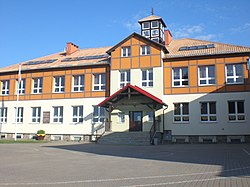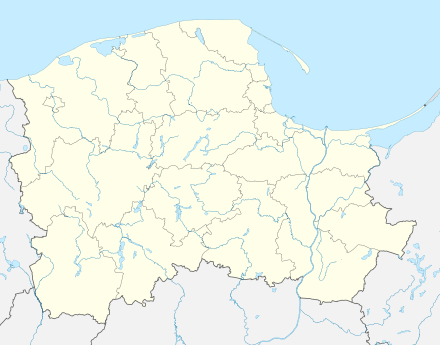Borzechowo
Borzechowo [bɔʐɛˈxɔvɔ] (German: Bordzichow, 1942-45: Borschau) is a village in the administrative district of Gmina Zblewo, within Starogard County, Pomeranian Voivodeship, in northern Poland.[1] It lies approximately 6 kilometres (4 mi) south of Zblewo, 15 km (9 mi) south-west of Starogard Gdański, and 57 km (35 mi) south of the regional capital Gdańsk. It is located within the ethnocultural region of Kociewie in the historic region of Pomerania.
Borzechowo | |
|---|---|
Village | |
 School in Borzechowo | |
 Borzechowo  Borzechowo | |
| Coordinates: 53°53′15″N 18°20′57″E | |
| Country | |
| Voivodeship | Pomeranian |
| County | Starogard |
| Gmina | Zblewo |
| Highest elevation | 120 m (390 ft) |
| Lowest elevation | 105 m (344 ft) |
| Population | 735 |
| Time zone | UTC+1 (CET) |
| • Summer (DST) | UTC+2 (CEST) |
The village has a population of 735.
The landmark of Borzechowo is the Saint Anne church.
History
Borzechowo was a royal village of the Polish Crown, administratively located in the Tczew County in the Pomeranian Voivodeship.[2] It was annexed by Prussia in the First Partition of Poland in 1772. Despite the annexation, in the 19th century the village's population remained overwhelmingly Polish.[3] After Poland regained independence in 1918, the village was restored to Poland.
During the German occupation of Poland (World War II), the Germans arrested the seven-member Polish family of Chamier-Gliszczyński, pre-war activists of the Polish minority in Germany, who stayed in the village after fleeing persecution in Germany.[4] They were imprisoned in Starogard Gdański and then murdered in the Szpęgawski Forest along with the owner of the house in which they stayed.[4] Teachers from Borzechowo were among Polish teachers murdered by the Germans on October 20, 1939 in the Szpęgawski Forest as part of the Intelligenzaktion.[5]
References
- "Central Statistical Office (GUS) - TERYT (National Register of Territorial Land Apportionment Journal)" (in Polish). 2008-06-01.
- Marian Biskup, Andrzej Tomczak, Mapy województwa pomorskiego w drugiej połowie XVI w., Toruń, 1955, p. 110 (in Polish)
- Słownik geograficzny Królestwa Polskiego i innych krajów słowiańskich, Tom I, Warszawa, 1880, p. 338 (in Polish)
- Maria Wardzyńska, Był rok 1939. Operacja niemieckiej policji bezpieczeństwa w Polsce. Intelligenzaktion, IPN, Warszawa, 2009, p. 81 (in Polish)
- Wardzyńska, p. 148-149